check engine Citroen C3 PICASSO 2014 1.G Owner's Manual
[x] Cancel search | Manufacturer: CITROEN, Model Year: 2014, Model line: C3 PICASSO, Model: Citroen C3 PICASSO 2014 1.GPages: 292, PDF Size: 9.23 MB
Page 5 of 292
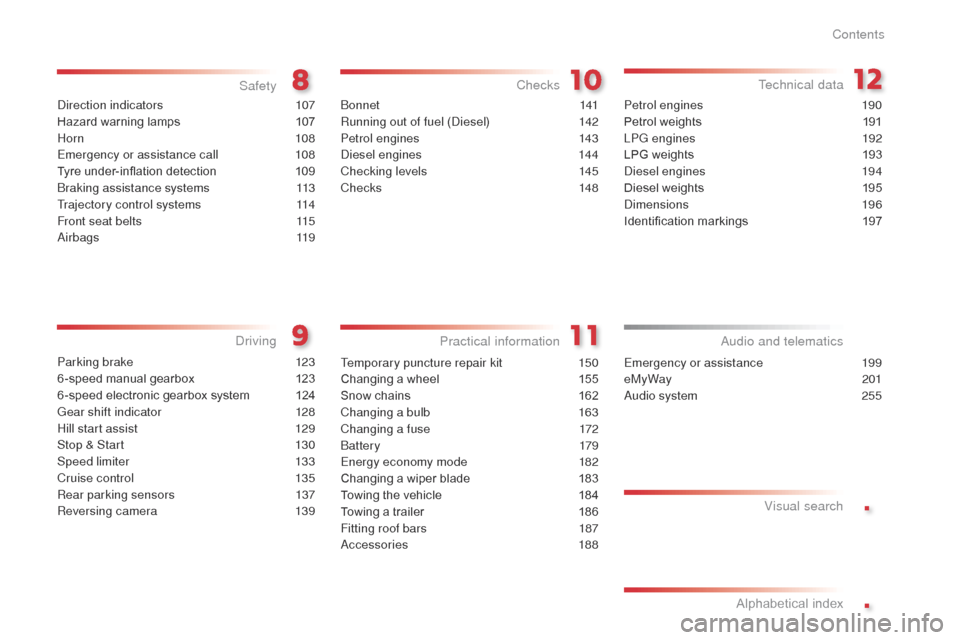
.
.
C3Picasso_en_Chap00a_sommaire_ed01-2014
direction indicators 107
Hazard warning lamps
1
07
Horn
108
Emergency or assistance call
1
08
Tyre under-inflation detection
1
09
br
aking assistance systems
1
13
Trajectory control systems
1
14
Front seat belts
1
15
air
bags
119
Safety
Parking brake 1 23
6 -speed manual gearbox
1
23
6 -speed electronic gearbox system
1
24
Gear shift indicator
1
28
Hill start assist
1
29
Stop & Start
1
30
Speed limiter
1
33
Cruise control
1
35
Rear parking sensors
1
37
Reversing camera
1
39
driving
Emergency or assistance 199
eMyWay
2
01
au
dio system
2
55
audio and telematics
Alphabetical index Visual search
bon n e t 1
41
Running out of fuel (
di
esel)
1
42
Petrol engines
1
43
di
esel engines
1
44
Checking levels
1
45
Checks
14
8
Checks
Temporary puncture repair kit 150
Changing a wheel
1
55
Snow chains
1
62
Changing a bulb
1
63
Changing a fuse
1
72
bat
tery
179
Energy economy mode
1
82
Changing a wiper blade
1
83
Towing the vehicle
1
84
Towing a trailer
1
86
Fitting roof bars
1
87
ac
cessories
188
Practical information Technical data
Petrol engines 1
90
Petrol weights
1
91
LPG engines
1
92
LPG weights
1
93
di
esel engines
1
94
Diesel weights
1
95
di
mensions
196
Identification markings
1
97
Contents
Page 11 of 292
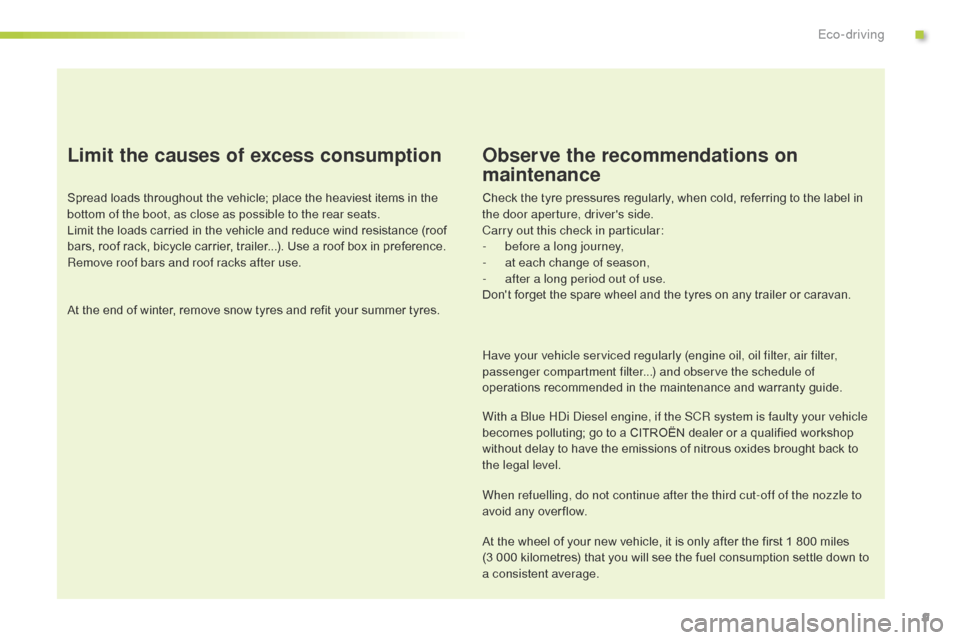
9
C3Picasso_en_Chap00c_eco-conduite_ed01-2014
Limit the causes of excess consumption
Spread loads throughout the vehicle; place the heaviest items in the
bottom of the boot, as close as possible to the rear seats.
Limit the loads carried in the vehicle and reduce wind resistance (roof
bars, roof rack, bicycle carrier, trailer...). Use a roof box in preference.
Remove roof bars and roof racks after use.
At the end of winter, remove snow tyres and refit your summer tyres.
Observe the recommendations on
maintenance
Check the tyre pressures regularly, when cold, referring to the label in
the door aperture, driver's side.
Carry out this check in particular:
-
b
efore a long journey,
-
a
t each change of season,
-
a
fter a long period out of use.
Don't forget the spare wheel and the tyres on any trailer or caravan.
Have your vehicle serviced regularly (engine oil, oil filter, air filter,
passenger compartment filter...) and observe the schedule of
operations recommended in the maintenance and warranty guide.
With a
b
l
ue H
di
d
i
esel engine, if the SCR system is faulty your vehicle
becomes polluting; go to a CITROËN dealer or a qualified workshop
without delay to have the emissions of nitrous oxides brought back to
the legal level.
When refuelling, do not continue after the third cut-off of the nozzle to
avoid any over flow.
At the wheel of your new vehicle, it is only after the first 1 800 miles
(3
000 kilometres) that you will see the fuel consumption settle down to
a consistent average.
.
Eco-driving
Page 17 of 292
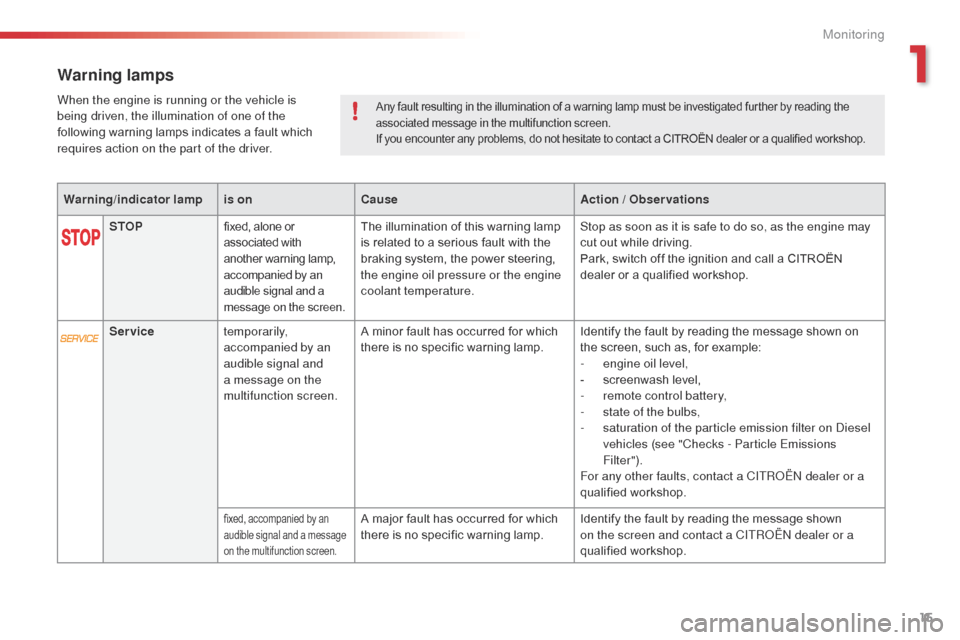
15
C3Picasso_en_Chap01_controle-de-marche_ed01-2014
Warning lamps
Warning/indicator lampis on Cause Action / Observations
STOP
fixed, alone or
associated with
another warning lamp,
accompanied by an
audible signal and a
message on the screen.The illumination of this warning lamp
is related to a serious fault with the
braking system, the power steering,
the engine oil pressure or the engine
coolant temperature. Stop as soon as it is safe to do so, as the engine may
cut out while driving.
Park, switch off the ignition and call a CITROËN
dealer or a qualified workshop.
Service temporarily,
accompanied by an
audible signal and
a message on the
multifunction screen. A minor fault has occurred for which
there is no specific warning lamp.
Identify the fault by reading the message shown on
the screen, such as, for example:
-
e
ngine oil level,
-
s
creenwash level,
-
r
emote control battery,
-
s
tate of the bulbs,
-
s
aturation of the particle emission filter on d
i
esel
vehicles (see "Checks - Particle Emissions
Filter").
For any other faults, contact a CITR
oËn
dealer or a
qualified workshop.
fixed, accompanied by an
audible signal and a message
on the multifunction screen.A major fault has occurred for which
there is no specific warning lamp. Identify the fault by reading the message shown
on the screen and contact a CITRoËn
dealer or a
qualified workshop.
Any fault resulting in the illumination of a warning lamp must be investigated further by reading the
associated message in the multifunction screen.
If you encounter any problems, do not hesitate to contact a CITROËN dealer or a qualified workshop.When the engine is running or the vehicle is
being driven, the illumination of one of the
following warning lamps indicates a fault which
requires action on the part of the driver.
1
Monitoring
Page 18 of 292
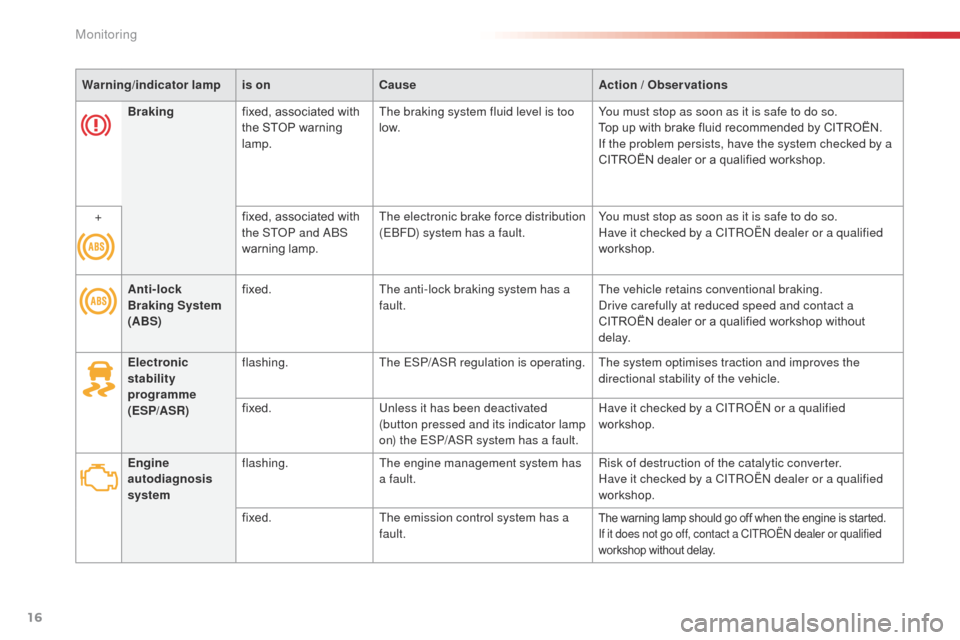
16
C3Picasso_en_Chap01_controle-de-marche_ed01-2014
Warning/indicator lampis on Cause Action / Observations
Anti-lock
Braking System
(ABS) fixed.
The anti-lock braking system has a
fault. The vehicle retains conventional braking.
dr
ive carefully at reduced speed and contact a
CITROËN dealer or a qualified workshop without
d e l ay.
Electronic
stability
programme
(ESP/ASR) flashing.
The ESP/
aS
R regulation is operating. The system optimises traction and improves the directional stability of the vehicle.
fixed. Unless it has been deactivated
(button pressed and its indicator lamp
on) the ESP/
aS
R system has a fault.Have it checked by a CITR
oËn
or a qualified
workshop.
Engine
autodiagnosis
system flashing.
The engine management system has
a fault. Risk of destruction of the catalytic converter.
Have it checked by a CITR
oËn
dealer or a qualified
workshop.
fixed. The emission control system has a
fault.
The warning lamp should go off when the engine is started.
If it does not go off, contact a CITRoËn
dealer or qualified
workshop without delay.
Braking fixed, associated with
the STOP warning
lamp. The braking system fluid level is too
low.
You must stop as soon as it is safe to do so.
Top up with brake fluid recommended by CITROËN.
If the problem persists, have the system checked by a
CITROËN dealer or a qualified workshop.
+ fixed, associated with
the ST
oP a
nd ab
S
w
arning lamp. The electronic brake force distribution
(E
bFd) s
ystem has a fault.You must stop as soon as it is safe to do so.
Have it checked by a CITR
oËn
dealer or a qualified
workshop.
Monitoring
Page 20 of 292
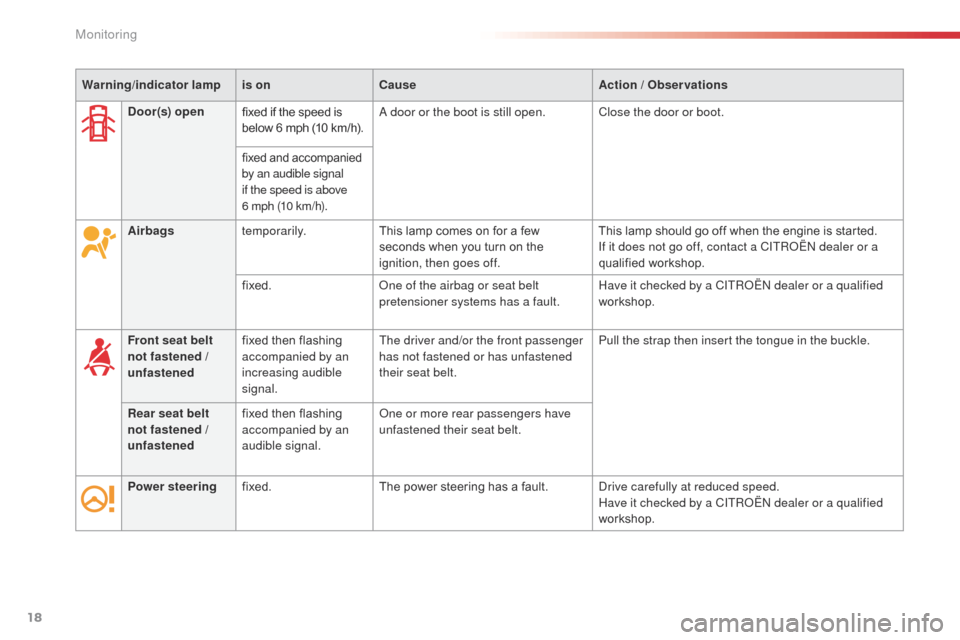
18
C3Picasso_en_Chap01_controle-de-marche_ed01-2014
Warning/indicator lampis on Cause Action / Observations
Airbags temporarily. This lamp comes on for a few
seconds when you turn on the
ignition, then goes off. This lamp should go off when the engine is started.
If it does not go off, contact a CITR
oËn
dealer or a
qualified workshop.
fixed.
on
e of the airbag or seat belt
pretensioner systems has a fault. Have it checked by a CITR
oËn
dealer or a qualified
workshop.
Front seat belt
not fastened /
unfastened fixed then flashing
accompanied by an
increasing audible
signal. The driver and/or the front passenger
has not fastened or has unfastened
their seat belt.
Pull the strap then insert the tongue in the buckle.
Rear seat belt
not fastened /
unfastened fixed then flashing
accompanied by an
audible signal.
on
e or more rear passengers have
unfastened their seat belt.
Power steering fixed. The power steering has a fault.
dr
ive carefully at reduced speed.
Have it checked by a CITR
oËn
dealer or a qualified
workshop.
Door(s) open
fixed if the speed is
below 6 mph (10 km/h).a door or the boot is still open. C
lose the door or boot.
fixed and accompanied
by an audible signal
if the speed is above
6
mph (10 km/h).
Monitoring
Page 24 of 292
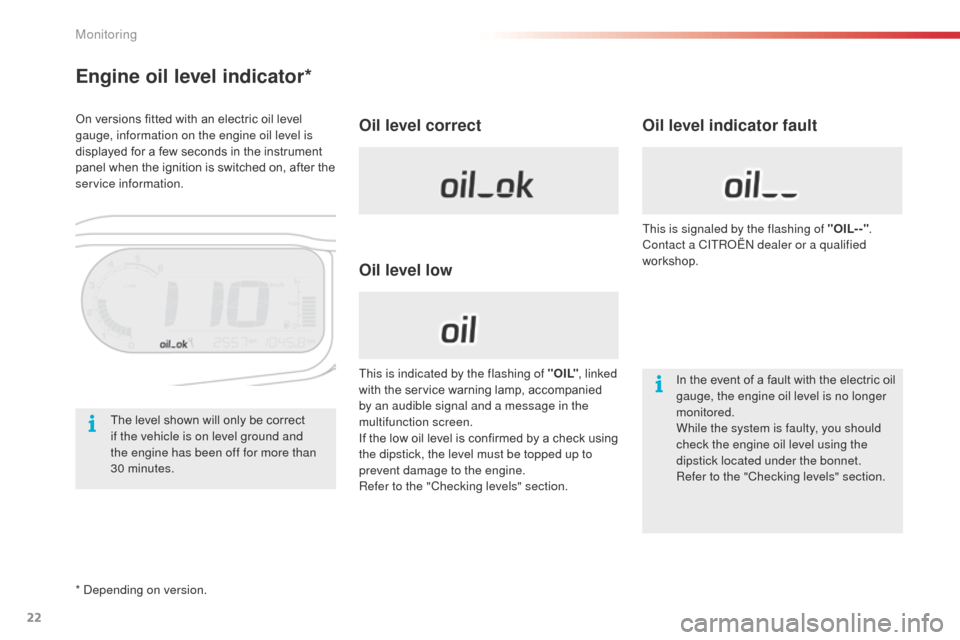
22
C3Picasso_en_Chap01_controle-de-marche_ed01-2014
Engine oil level indicator*
Oil level correct
Oil level lowOil level indicator fault
In the event of a fault with the electric oil
gauge, the engine oil level is no longer
monitored.
While the system is faulty, you should
check the engine oil level using the
dipstick located under the bonnet.
Refer to the "Checking levels" section.
This is indicated by the flashing of " O I L"
, linked
with the service warning lamp, accompanied
by an audible signal and a message in the
multifunction screen.
If the low oil level is confirmed by a check using
the dipstick, the level must be topped up to
prevent damage to the engine.
Refer to the "Checking levels" section. This is signaled by the flashing of "OIL- -"
.
Contact a CITR
oËn
dealer or a qualified
workshop.
The level shown will only be correct
if the vehicle is on level ground and
the engine has been off for more than
30
minutes.
On versions fitted with an electric oil level
gauge, information on the engine oil level is
displayed for a few seconds in the instrument
panel when the ignition is switched on, after the
service information.
*
d
ep
ending on version.
Monitoring
Page 43 of 292
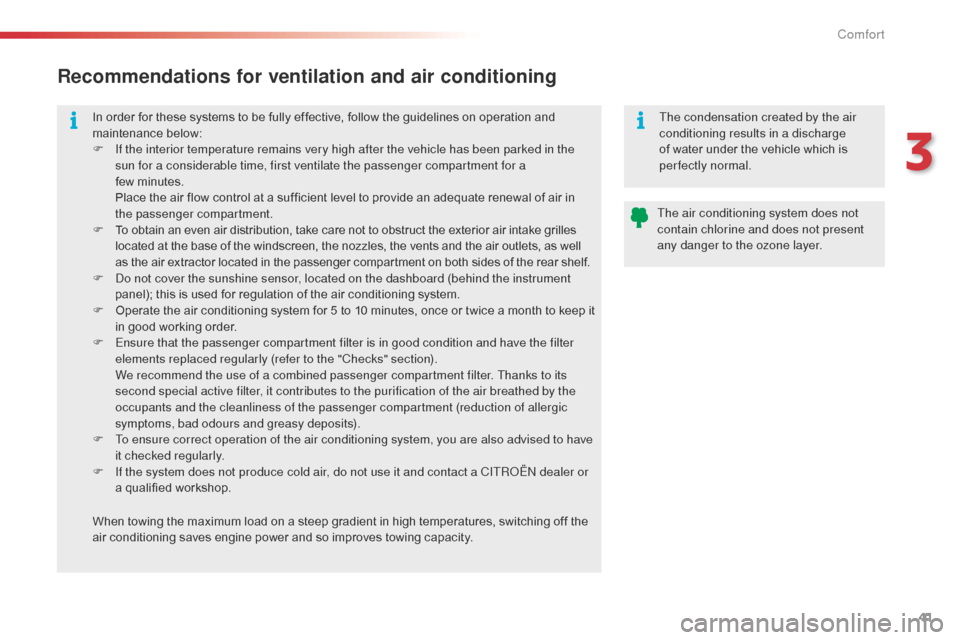
41
C3Picasso_en_Chap03_confort_ed01-2014
In order for these systems to be fully effective, follow the guidelines on operation and
maintenance below:
F
I
f the interior temperature remains very high after the vehicle has been parked in the
sun for a considerable time, first ventilate the passenger compartment for a
few minutes.
P
lace the air flow control at a sufficient level to provide an adequate renewal of air in
the passenger compartment.
F
T
o obtain an even air distribution, take care not to obstruct the exterior air intake grilles
located at the base of the windscreen, the nozzles, the vents and the air outlets, as well
as the air extractor located in the passenger compartment on both sides of the rear shelf.
F
d
o n
ot cover the sunshine sensor, located on the dashboard (behind the instrument
panel); this is used for regulation of the air conditioning system.
F
O
perate the air conditioning system for 5 to 10 minutes, once or twice a month to keep it
in good working order.
F
E
nsure that the passenger compartment filter is in good condition and have the filter
elements replaced regularly (refer to the "Checks" section).
W
e recommend the use of a combined passenger compartment filter. Thanks to its
second special active filter, it contributes to the purification of the air breathed by the
occupants and the cleanliness of the passenger compartment (reduction of allergic
symptoms, bad odours and greasy deposits).
F
T
o ensure correct operation of the air conditioning system, you are also advised to have
it checked regularly.
F
I
f the system does not produce cold air, do not use it and contact a CITR
oËn
dealer or
a qualified workshop. The air conditioning system does not
contain chlorine and does not present
any danger to the ozone layer.
When towing the maximum load on a steep gradient in high temperatures, switching off the
air conditioning saves engine power and so improves towing capacity.
Recommendations for ventilation and air conditioning
The condensation created by the air
conditioning results in a discharge
of water under the vehicle which is
perfectly normal.
3
Comfort
Page 61 of 292
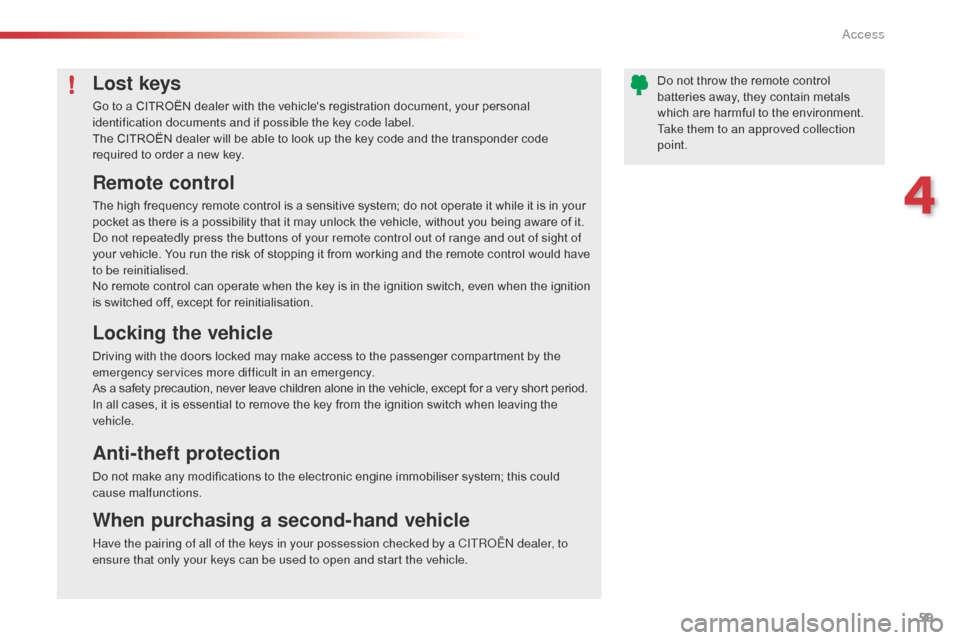
59
C3Picasso_en_Chap04_ouverture_ed01-2014
Remote control
The high frequency remote control is a sensitive system; do not operate it while it is in your
pocket as there is a possibility that it may unlock the vehicle, without you being aware of it.
do n
ot repeatedly press the buttons of your remote control out of range and out of sight of
your vehicle. You run the risk of stopping it from working and the remote control would have
to be reinitialised.
No remote control can operate when the key is in the ignition switch, even when the ignition
is switched off, except for reinitialisation.
Locking the vehicle
Driving with the doors locked may make access to the passenger compartment by the
emergency services more difficult in an emergency.
As a safety precaution, never leave children alone in the vehicle, except for a very short period.
In all cases, it is essential to remove the key from the ignition switch when leaving the
vehicle.
Anti-theft protection
Do not make any modifications to the electronic engine immobiliser system; this could
cause malfunctions.
When purchasing a second-hand vehicle
Have the pairing of all of the keys in your possession checked by a CITRoËn dealer, to
ensure that only your keys can be used to open and start the vehicle.
Lost keys
Go to a CITROËN dealer with the vehicle's registration document, your personal
identification documents and if possible the key code label.
The CITROËN dealer will be able to look up the key code and the transponder code
required to order a new key. Do not throw the remote control
batteries away, they contain metals
which are harmful to the environment.
Take them to an approved collection
point.
4
access
Page 69 of 292

67
C3Picasso_en_Chap04_ouverture_ed01-2014
Fuel tank
Low fuel levelFilling
A label affixed to the inside of the flap reminds
you of the type of fuel to be used depending on
your engine.
When the low fuel level is reached
this warning lamp comes on in the
instrument panel. When it first comes
on there remains approximately
5 litres of fuel in the tank. To fill the tank safely:
F
t
he engine must be switched off,
F
o
pen the fuel filler flap,
F
i
nsert the key in the cap, then turn it to the
left,
F
r
emove the cap and hook it onto the clip
located on the inside of the flap,
F
f
ill the tank, but do not continue after the
3rd cut- off of the pump ; this could cause
malfunctions.
When you have filled the tank:
F
p
ut the cap back in place,
F
t
urn the key to the right, then remove it
from the cap,
F
c
lose the flap.
ad
ditions of fuel must be of at least
5
litres to be registered by the fuel
gauge.
The key cannot be removed from the
lock until the cap is refitted.
op
ening the filler cap may create a
noise caused by an inrush of air. This
vacuum is entirely normal and results
from the sealing of the fuel system. With Stop & Start, never refuel with the
system in STOP mode; you must switch
off the ignition with the key.
Fuel tank capacity: approximately 50 litres
(petrol) or 48 litres (Diesel); (Depending
on version: approximately 30 litres
(petrol or Diesel)). For the LPG version:
approximately 33 litres.
You must refuel as soon as possible to avoid
running out of fuel.
If you run out of fuel (
di
esel), refer also to the
"Checks" section.
4
access
Page 71 of 292

69
C3Picasso_en_Chap04_ouverture_ed01-2014
Misfuel prevention (diesel)*
Operation
When a petrol filler nozzle is introduced into the
fuel filler neck of your
di esel vehicle, it comes
into contact with the flap. The system remains
closed and prevents filling.
Do not persist but introduce a Diesel type
filler nozzle.
*
a
c
cording to country of sale. It remains possible to use a fuel can to
fill the tank.
In order to ensure a good flow of fuel,
do not place the nozzle of the fuel can
in direct contact with the flap of the
misfuel prevention device and pour
s l ow l y.Travelling abroad
as
diesel fuel pump nozzles may
be different in other countries, the
presence of the misfuel prevention
device may make refuelling impossible.
Before travelling abroad, we
recommend that you check with the
CITROËN dealer network, whether your
vehicle is suitable for the fuel pumps in
the country in which you want to travel.
Mechanical device which prevents filling the tank of a Diesel vehicle with petrol. It avoids the risk of
engine damage that can result from filling with the wrong fuel.
Located in the filler neck, the misfuel prevention device appears when the filler cap is removed.
4
access